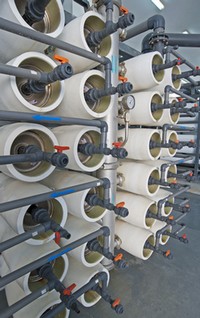 |
When salt was more precious than water desalination basic solar desalination was used and as the Europeans began to explore the world, the need for fresh water on ships and on remote islands became a priority. Thomas Jefferson designed a simple distillation process that could be easily described to anyone at sea, so in the event of an emergency they wouldn’t die of thirst. And in 1852, a British patent was issued for a distillation device. In 1928, the island of Curaçao in the Netherlands Antilles was the first place to make a major commitment to desalination and in 1938, a major seawater desalination plant was built in what is now Saudi Arabia.
Since the 1960’s desalination has increased from almost zero to 42million m3 per day with the two most common desalination technologies being membrane (56%) and thermal (43%). This increase in capacity and use has driven down costs from approximately $15 per 1,000 gallons in 1960 to roughly $2.50 per 1,000gallons today.
Membrane processes rely on permeable membranes to separate salts from water and can be pressure-driven (reverse osmosis or RO, the most common method used in desalination) or voltage-driven (electrodialysis). When two aqueous solutions of different concentrations are separated by a semi-permeable membrane, water diffuses through the membrane into the concentrated solution in a process called osmosis. The semi-permeable membrane allows water to pass through it, but prevents the passage of salts (ions) and other molecules from the concentrated solution. The osmotic flow continues until osmotic equilibrium is reached. The resulting pressure differential between the diluted and concentrated solutions is called the osmotic pressure and when a pressure, higher than the osmotic pressure, is mechanically applied to the concentrated solution pure water will flow through the membrane to the diluted solution, leaving dissolved salts and impurities behind. This phenomenon is called reverse osmosis.
Also known as distillation, thermal process desalination involves heating salt water to produce water vapor, which is then condensed and collected as fresh water with the salt and the impurities remaining in the desalination chamber. The evaporated water is then collected in the form of vapors, these gasses are then condensed and after few more treatments such as PH treatment, color treatment, chlorine addition etc, the water is then safely provided for domestic as well as industrial purposes.
Although its name implies that desalination is the removal of salt from water, in practice desalination plants can purify many other types of water making it suitable for drinking and irrigation. According to figures from the 19th IDA Worldwide Desalting plant inventory in 2006, in the US, desalination plants were used to convert 77% brackish water, 8% seawater, wastewater 8%, pure water 7% and brine <1%.
Throughthe use of deepwater wells we are able to access and purify much of the worlds untapped and undrinkable water and thanks to the advances in technology and investment, desalination has changed the way that communities and modern, high density cities gather enough freshwater to maintain a healthy population and expected standard of living.